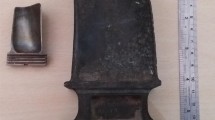Abstract
Numerical computation of gas turbine flowfields demands high computing power. In the present work, we present a detailed analysis of 3D computations for a highly loaded transonic blade and for a gas turbine stage. Comparison between experimental results and numerical computations reveals the precision limits of current modeling assumptions. Computations are performed using a time-marching approach coupled with a mixing-plane model for the exchange of flowfields between stator and rotor domains. Eddy viscosity turbulence models are applied to compute the flow with and without wall functions. Limitations in performance assessment are presented regarding the level of detail used for the geometry definition, the mixing-plane approach, and the near wall turbulence model employed.
Similar content being viewed by others
References
U. Köller, R. Mönig, B. Küsters and H-A. Schreiber, Development of advanced compressor airfoils for heavy-duty gas turbines — Part 1: design and optimization, Journal of Turbomachinery, 122 (2006) 397–405.
J. C. Páscoa, J. K. Luff, J. J. McGuirk and A. C. Mendes, On accurate numerical modeling of 3D turbulent flow through a DCA compressor cascade and its experimental validation, International Journal of Dynamics of Fluids, 2(1) (2006) 1–18.
S-B. Kwon, S-J Lee, S-Y Shin and S-H Kim, A study on the flow with nonequilibrium condensation in a minimum length nozzle, Journal of Mechanical Science and Technology, 23 (2009) 1736–1742.
C. H. Sohn and H. C. Cho, A CFD study on thermo-acoustic instability of methane/air flames in gas turbine combustor, Journal of Mechanical Science and Technology, 19(9) (2005) 1811–1820.
J. D. Denton, The calculation of three-dimensional viscous flow through multistage turbomachines, Journal of Turbomachinery, 114 (1992) 18–26.
J. C. Páscoa, A. C. Mendes and L. M. C. Gato, A fast iterative inverse method for turbomachinery blade design, Mechanical Research Communications, 36(5) (2009) 630–637.
J. C. Páscoa, A. C. Mendes and L. M. C. Gato, Aerodynamic design of turbomachinery cascades using an enhanced timemarching finite volume method, CMES — Computer Modeling in Engineering & Sciences, 6(6) (2004) 537–546.
B. Koobus, S. Camarri, M. V. Salvetti, S. Wornom and A. Dervieux, Parallel simulation of three-dimensional complex flows: Application to two-phase compressible flows and turbulent wakes, Advances in Engineering Software, 38(5) (2007) 328–337.
Y. Liu, Aerodynamics and heat transfer predictions in a highly loaded turbine blade, International Journal of Heat and Fluid Flow, 28 (2007) 932–937.
S. Djouimaa, L. Messaoudi and P. W. Giel, Transonic turbine blade loading calculations using different turbulence models — effects of reflecting and non-reflecting boundary conditions, Applied Thermal Engineering, 27 (2007) 779–787.
E. Göttlich, J. Woisetschläger, P. Pieringer, B. Hampel and F. Heitmeir, Investigation of vortex shedding and wakewake interaction in a transonic turbine stage using laserdoppler-velocimetry and particle-image-velocimetry, Journal of Turbomachinery, 128 (2006) 178–187.
L. Cutrone, P. D. Palma, G. Pascazio and M. Napolitano, Predicting transition in two and three-dimensional separated flows, International Journal of Heat and Fluid Flow, 29 (2008) 504–526.
D. Hanus, T. Censký, J. Neveceral and V. Horký, First stage of the centrifugal compressor design with tandem rotor blade, Proc. ISABE — 17 th International Symposium on Airbreathing Engines, Munich, Germany (2005) ISABE-2005-1161.
C. Xisto, Estudo da Física do Escoamento Secundárioe Modelação do Escoamento Turbulento 3D em Coroas de Pás de Turbinas, Dissertation (in Portuguese), University of Beira Interior, Covilhã, Portugal (2009).
G. Kalitzin, G. Medic, G. Iaccarino and P. Durbin, Nearwall behavior of RANS turbulence models and implications for wall functions, Journal of Computational Physics, 204 (2005) 265–291.
Author information
Authors and Affiliations
Corresponding author
Additional information
This paper was recommended for publication in revised form by Associate Editor Do Hyung Lee
José Carlos Páscoa is currently an Assistant Professor at University of Beira Interior in Portugal. He conducts research at the nationally funded Center for Aerospace Sciences and Technology, where he also serves as the secretary of the center’s scientific council. His main research interests are numerical modeling of compressible flow, including turbomachinery and MHD flow in MPD thrusters. José Páscoa holds a doctorate degree on numerical analysis and design of turbomachinery cascades of blades. Since 1997, he has been involved in turbomachinery research and has participated in several research projects. In 2002, he was a visiting academic at Rolls-Royce UTC of Loughborough University in UK.
Carlos M. C. Xisto is currently a PhD student at the nationally funded Center for Aerospace Sciences and Technology. In 2009, he earned a Master in Engineering degree in Electromechanical Engineering with a dissertation on numerical modeling of gas turbine flow. He has also achieved the Licenciatura degree in Electromechanical Engineering in 2008.
Emil Göttlich is a post-doctoral research fellow at the Institute for Thermal Turbomachinery and Machine Dynamics, Graz (Austria). He holds a PhD on “Experimental Investigation of Cooling and Unsteady Flow in Transonic High-Temperature Turbine Stages.” Furthermore, he has a Master in Mechanical Engineering combined with Economics degree from Graz University of Technology, where he also graduated in Mechanical Engineering combined with Economics. His main research interest is on energy engineering.
Rights and permissions
About this article
Cite this article
Páscoa, J.C., Xisto, C. & Göttlich, E. Performance assessment limits in transonic 3D turbine stage blade rows using a mixing-plane approach. J Mech Sci Technol 24, 2035–2042 (2010). https://doi.org/10.1007/s12206-010-0713-9
Received:
Revised:
Accepted:
Published:
Issue Date:
DOI: https://doi.org/10.1007/s12206-010-0713-9




